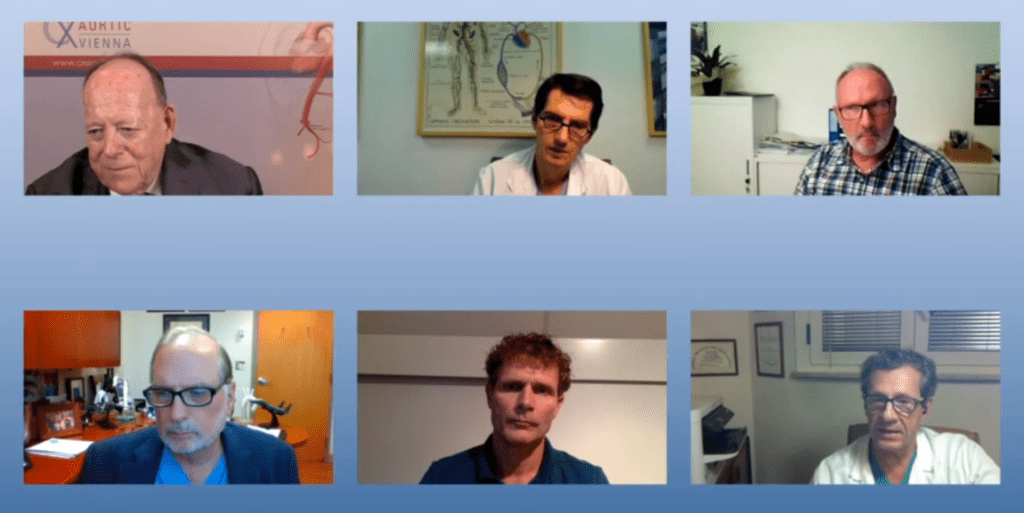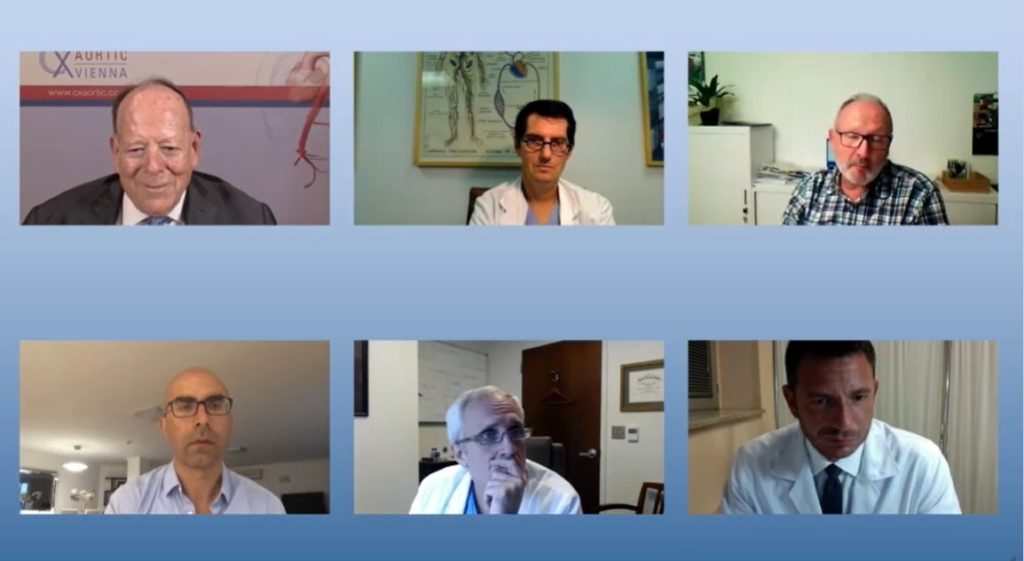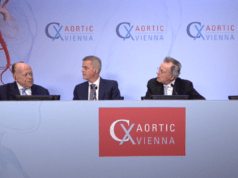
The spotlight turned to the topic of thoracic aortic dissections—both type A and B using both endovascular and open approaches—in the final of CX Aortic Vienna’s six Wednesday sessions. Polling revealed that 94% of viewers believe timing of intervention is key for type B dissection, and discussion emphasised the benefits of staged procedures.
Joseph Bavaria (Philadelphia, USA) began with a presentation in which he advocated moving toward “a definitive aortic solution” in acute type A dissections—describing what he sees as a new paradigm for the open zone 2/1 arch with sequential delayed branch arch thoracic endovascular aortic repair (TEVAR). Bavaria presented outcomes from various Debakey type 1 dissection cases, describing these as “catastrophic”, and arguing in favour of a change in approach in order to improve outcomes. The key concept in doing so, he suggested, is a strategy involving zone 2 arch replacement with sequential branched TEVAR.

He said: “The future based on our data, our increased sophistication, and the availability of new technology is that in patients with less than 10‒15 years of life expectancy, usually >65 we use the classic hemi-arch operations. A patient with an arch tear or distal malperfusion this is appropriate patient for an on-table frozen elephant trunk procedure. In patients less who are less than 65 and stable, we perform a Zone 2 arch with possible sequential arch branch TEVAR, usually in a few weeks.”
Robin Heijmen (Nieuwegein, The Netherlands) then discussed the value of transapical access for thoracic aortic procedures. Heijmen opened noting that the true value of TEVAR is its less-invasive approach, adding that the transfemoral route is preferred in most cases. However, where there is severe iliofemoral pathology this may not be possible, he said, adding that in these instances transapical access can be an alternative. Transapical access involves approaching through the “apex” of the left ventricle. “In recent years in more than 15 patients we have used transapical TEVAR safely and effectively and do appreciate its value in treating thoracic aortic pathology in case of an inadequate peripheral access,” Heijmen commented.
Following on from Heijmen, Germano Melissano (Milan, Italy) detailed a new technical approach for type B dissection—the STABILISE concept—combining proximal descending aortic endografting with distal bare metal stenting. This technique results in a completely remodelled aorta throughout its whole length, according to Melissano. He also detailed the aims of the STABILISE Registry which is seeking to gather data on the use of the technique in 200 patients for a follow-up period of two years. The Registry has been included in the top 10 candidates of aortic disease trials found on clinical trials.gov, in a study published in the Journal of Internal Medicine.

According to Kevin Mani (Uppsala, Sweden) chronic type B aortic dissection can be successfully treated with TEVAR, however re-interventions are not uncommon, he told the CX Aortic Vienna audience, with the success of TEVAR dependent on the extension of the disease. In his presentation, covering the role of endovascular treatment in chronic type B aortic dissections, Mani reminded the audience that the endovascular toolbox includes both false lumen occlusion devices as well as thoracoabdominal fenestrated repair. “TEVAR is not a one-off treatment in chronic type B aortic dissections and you have to prepare for future battles,” he said.
“Move sooner”, was the message from William Jordan (Atlanta, USA) who offered the international CX Aortic Vienna audience his insights into the early treatment of type B aortic dissections. He noted that acute type B aortic dissection is a high risk condition, with a high rate of mortality, particularly for patients undergoing open repair and added that increasingly, treatment of type B aortic dissection has moved towards TEVAR in recent years. He then presented data on early versus late repair, using either TEVAR or open approaches—highlighting an improved 10-year survival in patients who underwent early repairs, specifically with TEVAR. Jordan concluded that endovascular therapy provides less invasive treatment for complex aortic pathology, and that early intervention is associated with better long-term survival.
Closing the session, Enrico Rinaldi (Milan, Italy) offered participants a series technical tips for the open repair of chronic type B dissection. He noted that European guidelines recommend open repair for patients aneurysmal or symptomatic chronic type B dissection with a low surgical risk. “When it is possible, open surgical repair still represents the treatment of choice for chronic type B aortic dissection,” Rinaldi said. His presentation highlighted the need for identification and management of the true and false lumen, proper graft selection based upon patient characteristics, challenges in intercostal artery reattachment and management of the ascending aorta.
This session, and all other sessions from day two of CX Aortic Vienna, is available to view on demand. Click here to register and access the recording.













